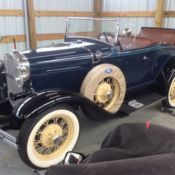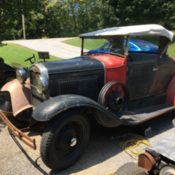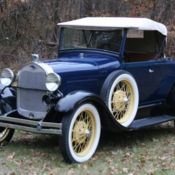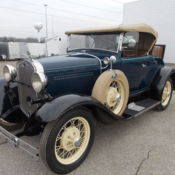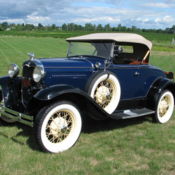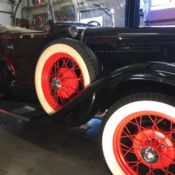1931 Ford Model A Deluxe Roadster Beautiful Car Low Reserve Collectible
Price: -
Item location: Hilton, New York, United States
Description:
1931 Ford Model A Deluxe Roadster
1931 Ford Model A Rumble Seat RoadsterBeautiful SHOW Condition Model A Roadster Deluxe Trimmed for as it is dressed to impress in every way.Side Mount Spare CarrierRear Trunk TrayRumble SeatWindshield WiperSpoked WheelsBeautiful TopTriple Plated GrilleVery SharpOur Model A IS Gorgeous!Finished in a Beautiful Two Tone Paint Scheme that accent its body lines and bring the beauty in functionality and design to the forefront.This particular car has been part of a private collection for many years after it was acquired by the collector whom paid handsomely for it at Hershey's annual auction where most of the vehicle are of this caliber and beyond.Good pedigree and can easily be at a car show where you would be sure to get recognized and take home top honors.Great example of what a MODEL A was and should still be!The Ford Model A (also colloquially called the A-Model Ford or the A, and A-bone among rodders and customizers), was the second huge success for the Ford Motor Company, after its predecessor, the Model T.First produced on October 20, 1927, but not sold until December 2, it replaced the venerable Model T, which had been produced for 18 years.This new Model A (a previous model had used the name in 1903-04) was designated a 1928 model and was available in four standard colors.By 4 February 1929, one million Model As had been sold, and by 24 July, two million. The range of body styles ran from the Tudor at US$500 (in grey, green, or black) to the Town Car with a dual cowl at US$1200.In March 1930, Model A sales hit three million, and there were nine body styles available. Model A production ended in March 1932, after 4,858,644 had been made in all body styles.Its successor was the Model B, which featured an updated inline four-cylinder engine, as well as the Model 18, which introduced Ford's new flathead (sidevalve) V8 engine.The Model A was the first Ford to use the standard set of driver controls with conventional clutch and brake pedals, throttle, and gearshift. Previous Fords used controls that had become uncommon to drivers of other makes.The Model A's fuel tank was situated in the cowl, between the engine compartment's fire wall and the dash panel. It had a visual fuel gauge, and the fuel flowed to the carburetor by gravity. A rear-view mirror was optional.In cooler climates, owners could purchase an aftermarket cast iron unit to place over the exhaust manifold to provide heat to the cab. A small door provided adjustment of the amount of hot air entering the cab.The Model A was the first car to have safety glass in the windshield. From the mid 1910s through the early 1920s, Ford dominated the automotive market with its Model T. However, during the mid-1920s, this dominance eroded as competitors, especially the various General Motors divisions, caught up with Ford's mass production system and began to better Ford in some areas, especially by offering more powerful engines, new convenience features, or cosmetic customization. Also, features Henry Ford considered to be unnecessary, such as electric starters, were gradually shifting in the public's perception from luxuries to essentials. Ford's sales force recognized the threat and advised Henry to respond to it. Initially he resisted, but the T's sagging market share finally forced him to admit a replacement was needed. When he finally agreed to begin development of this new model, he focused on the mechanical aspects and on what today is called design for manufacturability (DFM), which he had always strongly embraced and for which the Model T production system was famous. Although ultimately successful, the development of the Model A included many problems that had to be resolved. For example, the die stamping of parts from sheet steel, which the Ford company had led to new heights of development with the Model T production system, was something Henry had always been ambivalent about; it had brought success, but he felt that it was not the best choice for durability. He was determined that the Model A would rely more on drop forgings than the Model T; but his ideas to improve the DFM of forging did not prove practical. Eventually, Ford's engineers persuaded him to relent, lest the Model A's production cost force up its retail price too much. Henry's disdain for cosmetic vanity as applied to automobiles led him to leave the Model A's styling to a team led by his son Edsel, even though he would take credit for it despite his son doing more of the work.Thank you for looking at our listing and please don't hesitate to contact us with any and all questions!!!Good Luck and Happy Bidding!!!Vehicle Details:
- Make: Ford
- Model: Model A
- SubModel: Model A
- Type: Convertible
- Trim: Deluxe Roadster
- Doors: 2 Doors
- Year: 1931
- Mileage: 1
- VIN: A4303325Z
- Color: Blue
- Engine size: I4 3.3L
- Number of cylinders: 4
- Fuel: Gasoline
- Transmission: Manual
- Drive type: RWD
- Interior color: Tan
- Vehicle Title: Clear Want to buy? Contact seller!














